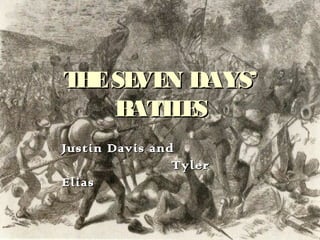
THE SEVEN DAYS' BATTLES
- 1. T E SE N DAYS’ H VE B TE AT L S Justin Davis and Tyler Elias
- 2. INTRODUCTION Good evening and welcome to this presentation created by Justin Davis and Tyler Elias. In these next slides, we will be giving you information about the Seven Days’ battles of the Civil War.
- 3. WHAT WERE THE SEVEN DAYS’ BATTLES The Seven Days’ battles were a series of six major battles: – Oak Grove – Mechanicsville – Gaines’ Mill – Savage’s Station – Glendale – Malvern Hill The Seven Days’ battles took place near Richmond, Virginia from June 25- July 1, 1862. The strategic objective for the Union was to take the Confederate capital, Richmond. The Confederate goal was to defend it.
- 4. ROBERT E. LEE Robert Edward Lee was born Jan. 19, 1807 in Stratford, Virginia. He was ranked second in his class at West Point in 1829. He became the commander of the Army of Northern Virginia in 1862 In February 1865 he was given command of all the Southern armies. On April 9, 1865, he surrendered to General Ulysses S. Grant at Appomattox Court House. He then became president of Washington College later that year. He died on October 12, 1870.
- 5. GEORGE B. M CLELLAN C George Brinton McClellan was born on December 3,1825 in Philadelphia, Pennsylvania. McClellan, like Lee, graduated second in his class at West Point in 1846. McClellan became the Union commander of the Army of the Potomac in 1862. His poor leadership skills caused Lincoln to relieve him of duty after the battle of Antietam. He ran for President as a Democrat for 1864 presidential election and lost to Lincoln. McClellan then became governor of New Jersey until 1881. He died on October 29,1885.
- 6. OAK GROVE Oak Grove was the first major battle of the Seven Days' battles. On June 25, General McClellan advanced his lines along the Williamsburg Road with the objective of bringing Richmond within range of his siege guns. Union forces attacked over swampy ground with uncertain results, and darkness stopped the fighting. General McClellan's attack was not strong enough to derail the Confederate offensive that already had been set in motion. The next day, General Lee seized the initiative by attacking at Beaver Dam Creek north of the Chickahominy.
- 7. MECHANICSVILLE The Battle of Beaver Dam Creek, also known as the Battle of Mechanicsville , took place on June 26, 1862 as the second major battle of the Seven Days’ battles during the Peninsula Campaign of the American Civil War. It was the start of General McClellan’s offensive attack which threatened the Confederate capital of Richmond. General A.P. Hill forces his division, reinforced by General D.H. Hill's brigade, into a series of unsuccessful assaults against General Fitz John Porter's Fifth Corps, which occupied defensive works behind Beaver Dam Creek. Confederate attacks were driven back with heavy casualties. Porter withdrew his corps safely to Gaines’ Mill.
- 8. GAINES’ MILL Gaines’ Mill was the third major battle of the Seven Days’ campaign. On June 27, 1862, General Robert E. Lee improved his attacks against General Porter's V Corps, which had established a strong defensive line behind Boatswain's Swamp north of the Chickahominy River. Porter's reinforced Fifth Corps held fast for the afternoon against disjointed Confederate attacks, inflicting heavy casualties. At dusk, the Confederates mounted a coordinated assault that broke Porter's line. The Union army retreated across the river during the night. Gaines' Mill is said to have saved Richmond for the Confederacy in 1862.
- 9. SAVAGES’ STATION Savage’s Station was the fourth major battle of the Seven Days’ campaign. On June 29, the main body of the Union army began a general withdrawal toward the James River. General John Magruder pursued along the railroad and the Williamsburg Road and struck Sumner's Corps, which was the rearguard, with three brigades near Savage's Station. Union forces continued to withdraw across White Oak Swamp, abandoning supplies and more than 2,500 wounded soldiers in a field hospital. Tactical victory was unknown.
- 10. GLENDALE Glendale was the fifth major battle of the Seven Days’ campaign. On June 30, Union counterattacks by General Hooker's division sealed the break and saved their line of retreat. "Stonewall" Jackson's divisions were delayed by Franklin at White Oak Swamp. The Confederates made a weak attempt to turn the Union left flank at Turkey Bridge but was driven back by Federal Navy gunboats in the James River. That night, McClellan established a strong position on Malvern Hill. Victory is inconclusive.
- 11. MALVERN HILL Malvern Hill was the sixth and last major battle of the Seven Days’ campaign. On July 1, General Lee makes one last attack on the strong Union lines. General McClellan brings up artillery to back the infantry. The Confederates suffer heavy losses and they are forced to retreat.
- 12. BATTLE MAP
- 13. AFTERMATH Despite his victory, McClellan retreats to Harrison Landing to cross the James River. Strategically,the Confederates win the battles of the Seven Days. Richmond holds for about another three years.
- 18. BIBLIOGRAPHY http://www.sonofthesouth.net/ http://www.civilwar.org/ http://www.blueandgraytrail.com/
Notes de l'éditeur
- Porter's reinforced V Corps held fast for the afternoon against disjointed Confederate attacks, inflicting heavy casualties. At dusk, the Confederates mounted a coordinated assault that broke Porter's line. The Union army retreated across the river during the night. Porter's reinforced V Corps held fast for the afternoon against disjointed Confederate attacks, inflicting heavy casualties. At dusk, the Confederates mounted a coordinated assault that broke Porter's line. The Union army retreated across the river during the night.